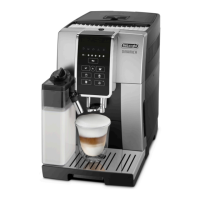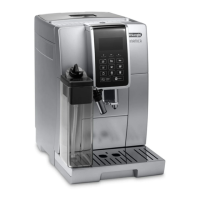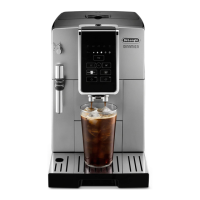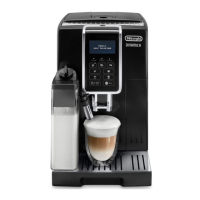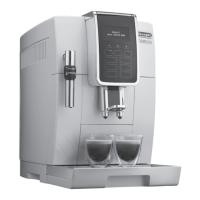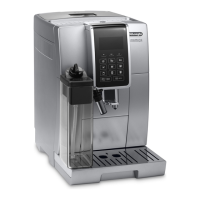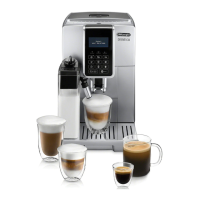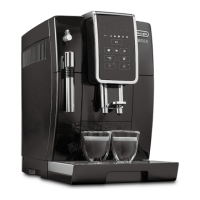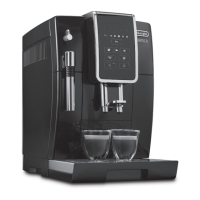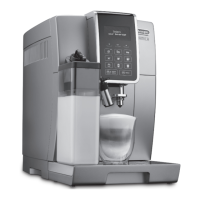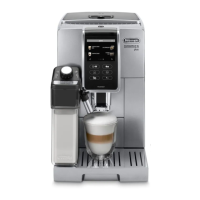10
Connect the appliance to an eciently earthed and correctly
installed socket with a minimum current rating of 10A only.
If the power socket does not match the plug on the appliance,
have the socket replaced with a suitable type by a qualied
professional.
5.4 Setting up the appliance
Please note:
• Coee has been used to factory test the appliance and it is
therefore completely normal for there to be traces of cof-
fee in the mill. The machine is, however, guaranteed to be
new.
You should customise water hardness as soon as possible follow-
ing the instructions in section “20. Setting water hardness”.
Proceed as described:
1. Plug the appliance into the mains socket and press the
main switch (A6) on the back of the appliance (g. 1).
2. The light (B3) ashes on the touch screen (B): Re-
move the water tank (A17 - g. 2), ll to the MAX line with
fresh water (g. 3A) then put back in the appliance (g.
3B).
3. The icon (B14 - g. 5) ashes on the touch screen.
4. Place a container with a minimum capacity of 100 ml
under the cappuccino maker (A20) (g. 4).
5. Turn the steam/hot water dial to the "I" position (g. 6)
and press the OK icon (B15). Water is delivered
from the cappuccino maker.
6. When delivery stops automatically, the icon ashes
on the touch screen to indicate that the steam dial must be
turned back to the "O" position.
The appliance goes o.
To use it, press the button (A23 - g. 7).
Please note:
• The rst time you use the appliance, you need to make 4-5
cups of coee before it starts to give satisfactory results.
• To enjoy your coee even more and improve the perfor-
mance of your appliance, we recommend installing a
water softener lter (C4) as described in section “21. Water
softener lter”. If your model is not provided with a lter,
you can request one from De'Longhi Customer Services.
6. TURNING THE APPLIANCE ON
Please note:
Before turning the appliance on, make sure the main switch
(A6) on the back of the appliance is pressed (g. 1).
Each time the appliance is turned on, it performs an automatic
preheat and rinse cycle which cannot be interrupted. The appli-
ance is ready for use only after completion of this cycle.
Danger of burns!
During rinsing, a little hot water comes out of the coee spouts
(A19) and is collected in the drip tray (A15) underneath. Avoid
contact with splashes of water.
• To turn the appliance on, press the button (A23) (g.
7). The light (B1) ashes on the touch screen (B) to in-
dicate the appliance is heating up.
While heating up, the machine performs a rinse cycle. As well
as heating the boiler, this also heats the internal circuits by cir-
culating hot water.
The appliance is at temperature when the light on the touch
screen goes o and the coee icons come on.
7. TURNING THE APPLIANCE OFF
Whenever the coee machine is turned o after being used to
make coee, it performs an automatic rinse cycle.
Danger of burns!
During rinsing, a little hot water ows from the coee spouts
(A19). Avoid contact with splashes of water.
• To turn the appliance o, press the button (A23 - g.
7);
• the light (B1) ashes on the touch screen and (if pro-
vided for) the appliance performs a rinse cycle then goes
o (standby).
Please note!
If you will not be using the appliance for some time, unplug
from the mains socket:
• rst turn the appliance o by pressing the button
(g. 7);
• release the main switch (A6) (g. 1).
Important!
Never press the main switch while the appliance is on.
8. SETTING WATER HARDNESS
For instructions on setting water hardness, see section “20. Set-
ting water hardness”.
9. SETTING TEMPERATURE
If you want to modify the temperature of the water used to
make the coee (low, medium, high, maximum), proceed as
follows:
1. With the appliance o (standby), but the main switch
pressed (g. 1);
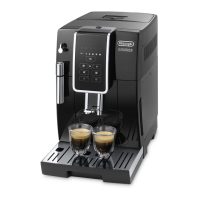
